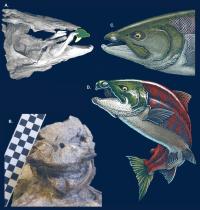Copy Link
Add to Bookmark
Report
AIList Digest Volume 5 Issue 065

AIList Digest Thursday, 5 Mar 1987 Volume 5 : Issue 65
Today's Topics:
Queries - Frame+Rule-Based Systems & Case-Based Reasoning &
Tracking Multiple Agents & AI Software on Intel-310 w/ Xenix &
AML-V on RS-1 or RS-2,
Reasoning - What is the Color of Clyde?,
Methodology - Algorithm Description & Expert System Explanations,
Philosophy - Consciousness,
Seminar - AI from the Bottom Up (CMU)
----------------------------------------------------------------------
Date: Mon, 2 Mar 87 21:30 EST
From: STREIFF%HARTFORD.BITNET@wiscvm.wisc.edu
Subject: Frame+Rule Based Systems
Hi,
Im looking into writing a rule based expert system that uses frames
for knowledge representation. It will be written in common lisp. Has anyone
had any experience writing something of this nature? What are the advantages
and drawbacks? Any help would be appreciated. Thank you.
S. David Streiff
Univ of Hartford
West Hartford CT
BitNet: STREIFF@HARTFORD.BITNET
------------------------------
Date: 4 Mar 87 19:12:46 GMT
From: pulli@seismo.css.gov (Jay Pulli)
Subject: case-based reasoning
I am not a regular reader of this newsgroup and am thus unaware if
this subject has been discussed at length. I am interested in finding
some references on case based reasoning in ai. I'm interested in using
it in conjunction with some signal characterization work I have been doing.
Direct email to my address below would be greatly appreciated. Thanks in
advance.
/\
Jay J. Pulli / \ /\
Center for Seismic Studies _____/ \ / \ /\_____
Arlington, VA \ / \/
703/276-7900 \/
pulli@seismo
------------------------------
Date: Mon, 2 Mar 87 12:18 EST
From: DON%atc.bendix.com@RELAY.CS.NET
Subject: Request for information
I'm looking for references or discussions on associating
observations with agents in multi-agent domains. My concern
is not so much with determining the goodness of association
as it is with controlling which associations are explored
(i.e. controlling the search).
In particular, consider a domain in which the particular agents
are not known but the general types and proportions of each type
are known. There is a fixed set of sensors for observing these
agents. None of the sensors provides absolute identification nor
continuous observation. There is some knowledge about the
typical behaviors of the different types of agents. The
reasoner's problem is, when presented with a new sensor report,
to determine whether to associate the report with a new agent or
with a previously observed agent. The problem quickly becomes
one of controlling the search of previously observed agents
in order to see which are most likely to be associated with
the new report.
I have some ideas about the search, but I'd like to see other
published ideas or talk to those wiser than I before I expose
myself. Thank you for any consideration.
Don Mitchell Don@atc.bendix.com or
Bendix Aero. Tech. Ctr. Don%atc.bendix.com@relay.cs.net
9140 Old Annapolis Rd. (301)964-4156
Columbia, MD 21045
------------------------------
Date: 3 Mar 87 16:10:00 GMT
From: hqda-ai!merlin@smoke.brl.mil (David S. Hayes)
Subject: AI software on Intel-310 w/ Xenix
We're looking for any AI or lisp software that runs on an
Intel 310 under Xenix. We have some of these, and would like to
start using them, but we don't know what sorts of things are
available.
Please provide then name of the product, a short description,
the name of the vendor, and the vendor's phone number. Reply via
e-mail, as I don't want to saturate these newsgroups.
Thanks for the help,
--
David S. Hayes, The Merlin of Avalon
PhoneNet: (202) 694-6900
ARPA: merlin%hqda-ai.uucp@brl.arpa
UUCP: ...!seismo!sundc!hqda-ai!merlin
------------------------------
Date: Mon, 2 Mar 87 10:38:31 PST
From: John B. Nagle <jbn@glacier.stanford.edu>
Subject: AML-V on RS-1 or RS-2?
Is anyone running AML-V ("Gold Filling") on an IBM RS-1 (model 7510,
model E CPU)?
AML-V is a robot programming language. The RS-1 and RS-2 are IBM
robots, impressive six-axis machines with force-sensing grippers. If
you have an IBM disk pack, an RS-series robot probably built it. CMU,
and MIT have RS-2 robots; Stanford has an RS-1, which was the pre-production
model. IBM donated quite a number of these machines to various schools;
these robots are more general-purpose than most manufacturing plants
really need, but are excellent research tools.
AML stands for A Manufacturing Language. AML-V is an experimental
version developed at IBM's Yorktown Heights facility. Current work is on
AML-X, which runs on an IBM PC/AT. AML-V was developed around 1985 and
runs on the now-obsolete IBM Series I computers. The people who wrote AML-V
are known to me but no longer have the Series I machines running that
could build me the version I need. But such versions existed at one time,
and if someone out there has one configured for an RS-1, it would be
very valuable to me. The odds are excellent that someone who reads
AILIST has an 8" floppy around that is just what I'm looking for.
I'm working on a new approach to common-sense reasoning, one which
involves the use of solid geometric modelling techniques to provide deep
knowledge about the physical world. This leads naturally to robotic
applications. One distinct advantage to working with robots, incidentally,
is that the hype level is distinctly lower in the robotics community than
in the rest of the AI world. Robotics people tend to shut up until they
can demo.
Is anyone running AML-V ("Gold Filling") on an IBM RS-1 (model 7510,
model E CPU)? This usually runs on an RS-2, model 7565, with an
model F CPU, but I'm trying to get it to run on an RS-1, which is supposedly
possible. Is a different kernel required, or is it sufficient
to put the configuration file on the boot floppy using the programs on the
basic diagnostic diskette?
I presently have the original RS-1 software installed (7505-AAA), but
am upgrading to 7505-AAE ("Silver Lining 2 on 1") next week. 7505-AAA
doesn't seem to recognize the AML-V distribution diskette as a valid
volume. The tools for dealing with such problems are better in 7505-AAE,
(the QVOLS command, for example) and I may be able to solve the problem
then. But any advice from RS-1/RS-2 users would be appreciated.
John Nagle
Center for Design Research, Stanford.
415-856-0767.
------------------------------
Date: 2 Mar 87 10:15:57 GMT
From: Dekang Lindek <mcvax!cs.strath.ac.uk!lindek@seismo.CSS.GOV>
Reply-to: lindek@cs.strath.ac.uk (Dekang Lindek)
Subject: What is the color of Clyde?
Look, WORLD, here is a little default reasoning exercise:
95% of elephants have color grey.
40% of Royal Elephants have color yellow.
Clyde is a Royal Elephant.
The color of Clyde is likely to be:
a) Grey b) Yellow c) Red d) Unknown
Dekang Lin
Dept. of CS
Univ. of Strathclyde
26 Richmond Street
Glasgow, G1 1XH, U.K.
E-mail: ....!siesmo!mcvax!ukc!strath-cs!lindek
------------------------------
Date: Mon, 2 Mar 87 08:59 EST
From: Seth Steinberg <sas@bfly-vax.bbn.com>
Subject: Re: Vulgar tongue
Mr. Talmon misunderstood my argument. I did not come out against
symbolic notation - I argued that mathematical and logical notation are
not the appropriate symbolic notation for computer science. That is
why I gave a series of examples showing that many fields have developed
their own formalisms which are not variants of mathematical and logical
notation.
APL may look a lot like matrix algebra at first glance but it is
decidedly procedural. Similarly, PROLOG may look like mathematical
logic, but I don't recall Aristotle, Aquinas or Quine discussing
anything even vaguely like 'cut'. I could base a programming language
on chemical notation or architectural renderings, but understanding it
would STILL require reasoning about procedural execution.
Seth
------------------------------
Date: Wed, 4 Mar 87 08:08:46 est
From: m06242%mwvm@mitre.ARPA
Subject: Value of explanation facility in expert systems
In considering the value of an explanation facility to an expert
system, it is worthwhile to address the possible role of the system as
a training facility. The student who follows the reasoning process is
being led through the analytical structure devised by the systems
builders. Since courtesy requires us to assume they chose a rational,
efficient structure, the student can see an efficient approach to the
problem.
George Swetnam@MITRE
"Cats elsewhere may be green, but the cats here don't care."
-Kesh proverb
*
* George
------------------------------
Date: 2 Mar 87 10:55:00 EST
From: "WHITE::PSOTKA" <psotka%white.decnet@ari-hq1.ARPA>
Reply-to: "WHITE::PSOTKA" <psotka%white.decnet@ari-hq1.ARPA>
Subject: RE: AIList Digest V5 #58
It seems to me that we generally have very clear criteria
for consciousness (unlike much of the current discussion).
We usually ask someone if they remember what happened: if they
don't remember we tend to say they were unconscious. There
are some general exceptions that prove this rule; namely, people
do forget specific things but they generally know that they
have forgotten: i.e., some fragmented memories still hang around
to produce things like the Tip Of Tongue phenomenon where one knows
one knows something but can't retrieve it. That kind of
forgetting is clearly distinguished from being unconscious.
On the whole there are two kinds of unconsciousness: when one is
traumatized with a blow to the head, and when one is sleeping
(either naturally or drug-induced). Football players provide
everyday examples of the former: often after a violent blow someone
stands beside a player asking him what he remembers. A few minutes
later he is asked again. Usually when he remembers less the second
time, he is pronounced to have a concussion and removed from the
game for a while.
Sometimes then, he has no recollection of
having been asked the first time. Was he unconscious during
that first interrogation even though he replied clearly and firmly?
Well, on the whole I think that the event is strange and hard to
categorize. My response seems to be, "Well, he didn't APPEAR to be
unconscious, but I guess he was." It seems to fall into the
same category as sleepwalking or talking in one's sleep.
My speculative hunch about the topic is that consciousness produces memories
because consciousness involves a wierd kind of multiplexing
of a person's entire identity, the whole history of all
existing memories, with the current percept, the current end segment
of the stream of consciousness. There is an ongoing search and
matching and resolution of all existing memories, plans, predicates,
images, etc. with the current context. This seems to be necessary for
awareness, recognition, inferences, etc. and it also somehow results
in consciousness or IS consciousness.
Let's get to work to find out how and why!
------------------------------
Date: 26 Feb 87 16:46:17 EST
From: Marcella.Zaragoza@isl1.ri.cmu.edu
Subject: Seminar - AI from the Bottom Up (CMU)
AI SEMINAR
TOPIC: "Artificial Intelligence from the Bottom Up"
SPEAKER: Hans Moravec, Robotics
WHEN: Tuesday, March 3, 1987, 3:30 pm
WHERE: Wean Hall 5409
ABSTRACT
Computers were created to do arithmetic faster and better than
people. AI attempts to extend this superiority to other mental arenas.
Some mental activities require little data, but others depend on
voluminous knowledge of the world. Robotics was pursued in AI labs
partly to automate the acquisition of world knowledge. It was soon
noticed that the acquisition problem was less tractable than the mental
activities it was to serve. While computers often exhibited adult
level performance in difficult mental tasks, robotic controllers were
incapable of matching even infantile perceptual skills.
In hindsight the dichotomy is not surprising. Animal genomes
have been engaged in a billion year arms race among themselves, with
survival often awarded to the quickest to produce a correct action from
inconclusive perceptions. We are all prodigous olympians in perceptual
and motor areas, so good that we make the hard look easy. Abstract
thought, on the other hand, is a small new trick, perhaps less than a
hundred thousand years old, not yet mastered. It just looks hard when
we do it.
How hard and how easy? Average humans beings can be beaten at
arithmetic by a one operation per second machine, in logic problems
by 100 operations per second, at chess by 10,000 operations per second,
in some narrow "expert systems" areas by a million operations. Robotic
performance can not yet provide this same standard of comparison, but
a calculation based on retinal processes and their computer visual
equivalents suggests that 10 BILLION (10^10) operations per second are
required to do the job of the retina, and a TRILLION (10^12) to match the
bulk of the human brain.
Truly expert human performance may depend on mapping a problem
into structures originally constructed for perceptual and motor tasks -
so it can be internally visualized, felt, heard or perhaps smelled and
tasted. Such transformations give the trillion operations per second
engine a purchase on the problem. The same perceptual-motor structures
may also be the seat of "common sense", since they probably contain a
powerful model of the world - developed to solve the merciless life and
death problems of rapidly jumping to the right conclusion from the
slightest sensory clues.
Semilog plots of computer power hint that trillion operation per
second computers will be common in twenty to forty years. Can we
expect to program them to mimic the "hard" parts of human thought in
the same way that current AI program capture some of the easy parts?
It is unlikely that introspection of conscious thought can carry us
very far - most of the brain is not instrumented for introspection, the
neurons are occupied efficiently solving the problem at hand, as in the
retina. Neurobiologists are providing some very helpful
instrumentation extra-somatically, but not fast enough for the forty
year timetable.
Another approach is to attempt to parallel the evolution of
animal nervous systems by seeking situations with selection criteria
like those in their history. By solving similar incremental problems,
we may be driven, step by step, through the same solutions (helped,
where possible, by biological peeks at the "back of the book"). That
animals started with small nervous systems gives confidence that small
computers can emulate the intermediate steps, and mobile robots provide
the natural external forms for recreating the evolutionary tests we
must pass. By this "bottom up" route I hope one day to meet my "top
down" colleagues half way. Together we can then metaphorically drive
the golden spike that unites the two efforts.
------------------------------
End of AIList Digest
********************























